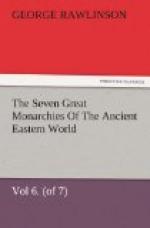But the nation which submits to be robbed of a province, however unproductive and valueless, must look to having the process repeated at intervals, until it bestirs itself and offers resistance. There is reason to believe that Phraates had no sooner conquered the Mardians than he cast his eyes on an adjacent district, and resolved to add it to his territories. This was the tract lying immediately to the West of the Caspian Gates, which was always reckoned to Media, forming, however, a distinct district, know as Media Rhagiana. It was a region of much natural fertility, being watered by numerous streams from the Elburz range, and possessing a soil of remarkable productiveness. Its breadth was not great, since it consisted of a mere strip between the mountains and the Salt Desert which occupies the whole centre of the Iranic tableland; but it extended in length at least a hundred and fifty miles, from the Caspian Gates to the vicinity of Kasvin. Its capital city, from a remote antiquity, was Rbages, situated near the eastern extremity of the strip, probably at the spot now called Kaleh Erij, about twenty-three miles from the “Gates.” On this region it is clear that Phraates cast a covetous eye. How much of it he actually occupied is doubtful; but it is at least certain that he effected a lodgment in its eastern extremity, which must have put the whole region in jeopardy. Nature has set a remarkable barrier between the more eastern and the more western portions of Occidental Asia, about midway in the tract which lies due south of the Caspian Sea. The Elburz range in this part is one of so tremendous a character, and northward abuts so closely on the Caspian, that all communication between the east and the west necessarily passes to the south of it. In this quarter the Great Desert offering an insuperable obstacle to transit, the line of communication has to cling to the flanks of the mountain chain, the narrow strip between the mountains and the desert—rarely ten miles in width—being alone traversable. But about long. 52 deg. 20’ this strip itself fails. A rocky spur runs due south from the Elburz into the desert for a distance of some twenty or thirty miles, breaking the line of communication, and seeming at first sight to obstruct it completely. This, however, is not the case absolutely. The spur itself is penetrable by two passes, one where it joins the Elburz, which is the more difficult of the two, and another, further to the south, which is easier. The latter now known as the Girduni Sudurrah pass, constitutes the famous “Pylae Caspiae.” Through this pass alone can armies proceed from Armenia, Media, and Persia eastward, or from Turkestan, Khorasan, and Afghanistan into the more western parts of Asia. The position is therefore one of primary importance. It was to guard it that Rhages was built so near the eastern end of its territory. So long as it remained in the possession of Syria, Parthian aggression was checked. Rhagiana, the rest of Media, and the




